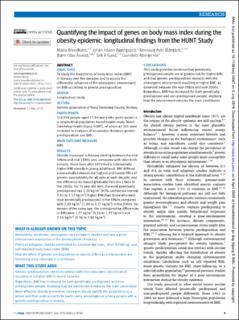| dc.contributor.author | Brandkvist, Maria Charlotta | |
| dc.contributor.author | Bjørngaard, Johan Håkon | |
| dc.contributor.author | Ødegård, Rønnaug | |
| dc.contributor.author | Åsvold, Bjørn Olav | |
| dc.contributor.author | Sund, Erik | |
| dc.contributor.author | Vie, Gunnhild Åberge | |
| dc.date.accessioned | 2020-04-14T07:37:17Z | |
| dc.date.available | 2020-04-14T07:37:17Z | |
| dc.date.created | 2019-09-13T14:45:57Z | |
| dc.date.issued | 2019 | |
| dc.identifier.citation | BMJ. British Medical Journal. 2019, 366 1-8. | en_US |
| dc.identifier.issn | 1756-1833 | |
| dc.identifier.uri | https://hdl.handle.net/11250/2650874 | |
| dc.description.abstract | Objectives: To study the trajectories of body mass index (BMI) in Norway over five decades and to assess the differential influence of the obesogenic environment on BMI according to genetic predisposition.
Design: Longitudinal study.
Setting: General population of Nord-Trøndelag County, Norway.
Participants: 118 959 people aged 13-80 years who participated in a longitudinal population based health study (Nord-Trøndelag Health Study, HUNT), of whom 67 305 were included in analyses of association between genetic predisposition and BMI.
Main outcome measure: BMI.
Results: Obesity increased in Norway starting between the mid-1980s and mid-1990s and, compared with older birth cohorts, those born after 1970 had a substantially higher BMI already in young adulthood. BMI differed substantially between the highest and lowest fifths of genetic susceptibility for all ages at each decade, and the difference increased gradually from the 1960s to the 2000s. For 35 year old men, the most genetically predisposed had 1.20 kg/m2 (95% confidence interval 1.03 to 1.37 kg/m2) higher BMI than those who were least genetically predisposed in the 1960s compared with 2.09 kg/m2 (1.90 to 2.27 kg/m2) in the 2000s. For women of the same age, the corresponding differences in BMI were 1.77 kg/m2 (1.56 to 1.97 kg/m2) and 2.58 kg/m2 (2.36 to 2.80 kg/m2).
Conclusions: This study provides evidence that genetically predisposed people are at greater risk for higher BMI and that genetic predisposition interacts with the obesogenic environment resulting in higher BMI, as observed between the mid-1980s and mid-2000s. Regardless, BMI has increased for both genetically predisposed and non-predisposed people, implying that the environment remains the main contributor. | en_US |
| dc.language.iso | eng | en_US |
| dc.publisher | BMJ Publishing Group | en_US |
| dc.rights | Navngivelse-Ikkekommersiell 4.0 Internasjonal | * |
| dc.rights.uri | http://creativecommons.org/licenses/by-nc/4.0/deed.no | * |
| dc.title | Quantifying the impact of genes on body mass index during the obesity epidemic: Longitudinal findings from the HUNT Study | en_US |
| dc.type | Peer reviewed | en_US |
| dc.type | Journal article | en_US |
| dc.description.version | publishedVersion | en_US |
| dc.source.pagenumber | 1-8 | en_US |
| dc.source.volume | 366 | en_US |
| dc.source.journal | BMJ. British Medical Journal | en_US |
| dc.identifier.doi | 10.1136/bmj.l4067 | |
| dc.identifier.cristin | 1724540 | |
| dc.relation.project | Stiftelsen Kristian Gerhard Jebsen: SKGJ-MED-015 | en_US |
| dc.relation.project | Norges forskningsråd: 250335 | en_US |
| dc.description.localcode | Copyright © 2019 Author(s). This is an open access article distributed under the terms of the Creative Commons CC-BY-NC 4.0License (http://creativecommons.org/licenses/by-nc/4.0/) | en_US |
| cristin.ispublished | true | |
| cristin.fulltext | original | |
| cristin.qualitycode | 2 | |

